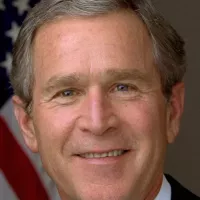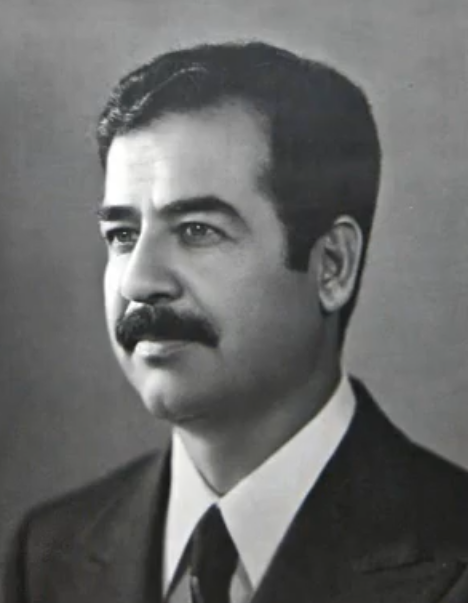Resilience and perseverance in the journey of Saddam Hussein. A timeline of obstacles and growth.
Saddam Hussein was the fifth president of Iraq from 1979 to 2003, following the American invasion. He was a key member of the Arab Socialist Ba'ath Party and advocated for Ba'athism, blending Arab nationalism and socialism. His political ideology is known as Saddamism. He previously served as Vice President (1968-1979) and Prime Minister (1979-1991, 1994-2003). His rule ended with his overthrow and subsequent capture.
October 1959: Assassination Attempt on Qasim
In October 1959, Saddam Hussein participated in the Ba'ath Party's assassination attempt on Qasim, though the attempt failed.
1959: Aftermath of Assassination Attempt on Qasim
In 1959, following the failed assassination attempt on Qasim, Saddam Hussein's biography highlights his fearlessness, loyalty, and resourcefulness in saving his comrades and escaping.
February 1960: Escape to Egypt
In February 1960, Saddam Hussein escaped to Egypt via Syria, finding refuge under Nasser's protection after the failed assassination attempt on Qasim.
February 1963: Ramadan Revolution Coup
In February 1963, the Ba'ath Party overthrew and killed Qasim in the Ramadan Revolution coup. Saddam Hussein was in exile in Egypt at the time.
November 1963: Anti-Ba'athist Coup
In November 1963, Abdul Salam Arif dismissed and arrested Ba'athist leaders in a coup, while Saddam Hussein was in exile in Egypt.
October 1964: Arrest and Imprisonment
In October 1964, Saddam Hussein was arrested and imprisoned for approximately two years for planning to assassinate Arif.
1973: Energy Crisis and Rising Oil Prices
In 1973, the world oil prices rose dramatically as a result of the 1973 energy crisis. This led to skyrocketing revenues enabling Saddam to expand his agenda.
1975: Defeat of Kurdish Rebels
In 1975, after US covertly financed Kurdish rebels during the Second Iraqi-Kurdish War, the Kurds were defeated leading to the forcible relocation of hundreds of thousands of Kurdish civilians.
1978: Crackdown on Iraqi Communists
In 1978, a crackdown on Iraqi Communists strained Iraqi relations with the Soviet Union, leading Iraq to take on a more Western orientation.
July 1979: Purge of Ba'ath Party Leaders
On July 22, 1979, Saddam Hussein convened an assembly of Ba'ath Party leaders and initiated a purge, claiming to have found a fifth column within the ruling party. 68 alleged co-conspirators were arrested. 22 were sentenced to execution, with other high-ranking members of the party forming the firing squad.
1979: Purge of Rivals
In 1979, after taking office as president, Saddam Hussein purged rivals within his party, consolidating his power.
1979: Countercoup Purges
In 1979, the "countercoup" purges happened. In June 1982, half of the sixteen RCC members who had survived the 1979 "countercoup" were removed from power.
1979: Period of Tension Between Iraq and Iran
Throughout 1979, a long period of tension between the two countries happened which resulted in war during September 1980, including frequent border skirmishes, calls by Khomeini for the Shia Muslims in Iraq to revolt against the ruling Ba'ath Party, and allegations of Iraqi support for ethnic separatists in Iran.
April 1980: Attempted Assassination of Tariq Aziz
On April 1, 1980, the Islamic Dawa Party, attempted to assassinate Tariq Aziz, Iraq's then deputy prime minister at the University of Baghdad campus, in retaliation for a 30 March decree declaring "membership of Dawa [to be] a capital offense".
September 1980: Outbreak of the Iran-Iraq War
The war in September 1980 was preceded by a long period of tension between Iraq and Iran throughout 1979 and 1980, including frequent border skirmishes. On 10 September 1980, Iraq forcibly reclaimed territories in Zain al-Qaws and Saif Saad that it had been promised under the terms of the 1975 Algiers Agreement but that Iran had never handed over.
1980: Invasion of Iran
In 1980, Saddam Hussein ordered the invasion of Iran, initiating a prolonged and devastating war.
1981: Israeli Attack on Iraq's Osirak Nuclear Reactor
In 1981, Israel carried out Operation Opera, a surprise attack on Iraq's unfinished Osirak nuclear reactor, with Iranian intelligence support, during the Iran-Iraq war where Israel was one of the main suppliers of military and intelligence support to Iran.
June 1982: Second Round of Purges
In June 1982, a second round of purges took place in the government, when half of the sixteen RCC members who had survived the 1979 "countercoup" were removed from power. Large numbers of Shias were removed from the regime. Later the government invited back Shi'as to held posts within the government, to gain support.
1982: Crimes Against Residents of Dujail
A few weeks later, he was charged by the Iraqi Special Tribunal with crimes committed against residents of Dujail in 1982, following a failed assassination attempt against him. Specific charges included the murder of 148 people, torture of women and children and the illegal arrest of 399 others.
1982: Killing of 148 Shia residents in Dujail
In 1982, 148 Shia residents in the town of Dujail were killed which led to Saddam Hussein being found guilty of crimes against humanity in November 2006.
February 1986: Blame for Defeat
In February 1986, Saddam's government blamed the Iraqi defeat in the First Battle of al-Faw on "misinformation from the U.S."
March 1988: Halabja Chemical Attack
On 16 March 1988, the Kurdish town of Halabja was attacked with chemical weapons, including mustard gas and nerve agents. The attack killed between 3,200 and 5,000 people, and injured 7,000 to 10,000 more, primarily civilians, during the Anfal campaign.
July 1988: Iran Accepts Resolution 598
On 20 July 1988, Iran accepted Resolution 598 of the United Nations Security Council. This acceptance was largely influenced by diminished morale, economic hardship, and the success of Iraq's Tawakalna ala Allah Operations, paving the way for a ceasefire in the Iran-Iraq War.
August 1988: Ceasefire Accepted
On 20 August 1988, Iran accepted Resolution 598, signaling a ceasefire, primarily due to a combination of factors including poor morale, economic collapse, and the success of Iraq's Tawakalna ala Allah Operations. This brought the Iran-Iraq war to an end after years of hostilities.
1988: Culmination of the Anfal Campaign
In 1988, the Anfal campaign, led by Ali Hassan al-Majid, reached its height. This campaign, conducted between 1986 and 1989, targeted the Kurdish population and other ethnic groups in Northern Iraq, resulting in the deaths of an estimated 50,000 to 182,000 people.
1990: Invasion of Kuwait
In 1990, Saddam Hussein invaded Kuwait, leading to international condemnation and the subsequent Gulf War.
1990: Economic Decline Due to Sanctions
In 1990, following the invasion of Kuwait and the imposition of United Nations sanctions, Iraq's GDP plummeted from US$44.36 billion in 1990 to US$9 billion by 1995 due to blocked Iraqi oil exports. The sanctions also restricted basic medical equipment and supplies from getting into Iraq.
January 1991: Start of Operation Desert Storm
On 16 January 1991, a U.S.-led coalition launched round-the-clock missile and aerial attacks on Iraq. This operation was backed by the Security Council and aimed to liberate Kuwait.
February 1991: Ejection from Kuwait
In February 1991, a ground force consisting largely of U.S. and British armored and infantry divisions ejected Saddam's army from Kuwait, occupying the southern portion of Iraq as far as the Euphrates.
March 1991: End of Gulf War and Cease-fire Agreement
In March 1991, the Gulf War concluded with a cease-fire agreement where Iraq agreed to dismantle its poison gas and germ weapons under UN supervision. UN trade sanctions remained until full compliance. Despite the defeat, Saddam Hussein publicly claimed victory. Bush announced a "new world order", emphasizing peace, security, freedom, and the rule of law.
1991: Saddam awarded Order of the Mother of Battles
In 1991, Saddam Hussein received the Order of the Mother of Battles for his role in the Gulf War against Kuwait and the United States.
1991: Gulf War
Until the Gulf War in 1991, Iraq had a more Western orientation following a crackdown on Iraqi Communists in 1978 and a shift of trade toward the West, strained Iraqi relations with the Soviet Union.
June 1993: U.S. Missile Attack on Iraq's Intelligence Headquarters
On 26 June 1993, the U.S. launched a missile attack on Iraq's intelligence headquarters in Baghdad, citing violations of the "no-fly zones" and incursions into Kuwait.
August 1995: Raghad and Rana defect to Jordan
In August 1995, Saddam Hussein's daughters, Raghad and Rana, along with their husbands, Hussein Kamel al-Majid and Saddam Kamel al-Majid, defected to Jordan with their children.
1995: Continued Economic Hardship Under Sanctions
By 1995, Iraq's GDP had plummeted to US$9 billion due to the UN sanctions imposed after the invasion of Kuwait in 1990. Iraq had lost around US$170 billion of oil revenues, and the sanctions restricted basic-medical equipment and supplies from getting into Iraq.
1995: CIA Attempt to Assassinate Saddam Hussein
In 1995, the CIA made an attempt to assassinate Saddam Hussein, amid a decade-long effort to encourage a military coup in Iraq.
February 1996: Kamel brothers killed after return to Iraq
In February 1996, the Kamel brothers were killed in a gunfight with clan members, just three days after returning to Iraq following assurances of a pardon from Saddam Hussein.
December 1996: Acceptance of the Oil-for-Food Programme
On 9 December 1996, Saddam Hussein's government accepted the Oil-for-Food Programme offered by the UN in 1992. This program was designed to ease the economic hardship caused by UN sanctions, which had significantly reduced Iraq's GDP since 1990.
1997: Crises over UN Access to Suspected Weapons Sites
Between 1997 and 1998, crises emerged due to Iraqi resistance to UN access to suspected weapons sites, leading to increased tensions with Western powers.
December 1998: U.S. and British Missile Strikes on Iraq
From 16–19 December 1998, the U.S. and Britain launched intensive missile strikes on Iraq, following Western charges of Iraqi resistance to U.N. access to suspected weapons sites.
1999: Suppression of Uprisings
In 1999, Saddam Hussein's forces suppressed further uprisings in Iraq, maintaining his grip on power.
February 2001: Increased U.S. and British Air Strikes Near Baghdad
In February 2001, after two years of intermittent activity, U.S. and British warplanes intensified their strikes on sites near Baghdad.
January 2002: Bush's "Axis of Evil" Address and Threat to Topple Iraqi Government
In January 2002, President George W. Bush delivered his state of the union address to Congress, in which he spoke of an "axis of evil" consisting of Iran, North Korea, and Iraq. Bush announced that he would possibly take action to topple the Iraqi government because of the threat of its weapons of mass destruction.
November 2002: Return of UN Weapons Inspectors to Iraq
In November 2002, following the passing of UN Security Council Resolution 1441, Saddam Hussein allowed U.N. weapons inspectors led by Hans Blix to return to Iraq. Blix found no stockpiles of WMD during the renewed inspections.
February 2003: Saddam's Interview with CBS News
On 24 February 2003, Saddam Hussein gave an interview with CBS News reporter Dan Rather, denying the possession of weapons of mass destruction. He expressed a desire for a televised debate with George W. Bush, which was declined.
March 2003: Invasion of Iraq by U.S.-Led Coalition Forces
In March 2003, the United States-led coalition forces initiated the invasion of Iraq. Within three weeks, the Iraqi government and military collapsed, and by early April, coalition forces occupied much of Iraq.
April 2003: Uncertainty Regarding Saddam's Whereabouts
In April 2003, following the fall of Baghdad, Saddam Hussein's whereabouts were unknown. He released audio tapes promoting popular resistance to his ousting.
December 2003: Capture of Saddam Hussein in Operation Red Dawn
On 13 December 2003, Saddam Hussein was captured by American forces in Operation Red Dawn, found hiding in a hole near ad-Dawr, near Tikrit. US administrator Paul Bremer confirmed the capture on 14 December and presented video footage of Saddam in custody.
2003: Overthrow After American Invasion
In 2003, Saddam Hussein was overthrown following the American invasion of Iraq, ending his presidency.
2003: US-Led Invasion and Capture
In 2003, a US-led coalition invaded Iraq, leading to the toppling of Saddam Hussein's regime and his subsequent capture.
June 2004: Transfer of Saddam to Interim Iraqi Government Custody
On 30 June 2004, Saddam Hussein, along with 11 other senior Ba'athist leaders, was transferred from US custody at Camp Cropper to the interim Iraqi government to stand trial for crimes against humanity and other offences.
November 2006: Saddam found guilty and sentenced to death
In November 2006, Saddam Hussein was found guilty of crimes against humanity for the killing of 148 Shia residents in Dujail in 1982 and sentenced to death by hanging. His half-brother, Barzan Ibrahim, and Awad Hamed al-Bandar, were also convicted and sentenced to death.
December 2006: Saddam Hussein executed by hanging
On December 30, 2006, Saddam Hussein was executed by hanging at Camp Justice in Baghdad. This occurred despite his request to be executed by firing squad due to his role as commander-in-chief.
Mentioned in this timeline

Donald John Trump is an American politician media personality and...

George W Bush the rd U S President - is...
The United States of America is a federal republic located...
CBS Broadcasting Inc CBS is a prominent American commercial broadcast...
The Union of Soviet Socialist Republics USSR existed from to...
CNN Cable News Network is a multinational news organization founded...
Trending

2 months ago Travis Scott's Epic Johannesburg Performance: Fans Brave Weather for Unforgettable Show

6 months ago Immanuel Iheanacho, a five-star OT, narrows down top schools, including LSU Tigers.
17 days ago Dylan Raiola Transfer Rumors Surface; Brother Decommits from Nebraska, Future Uncertain

24 days ago Bitwise Launches XRP ETF Amidst Market Activity; XRP Staking Explored.
2 months ago Kansas Jayhawks face UCF Knights: Sorsby's performance crucial in Big 12 matchup.
Jaylen Warren is a professional American football running back currently playing for the Pittsburgh Steelers in the NFL He had...
Popular

Candace Owens is an American conservative political commentator and author...

Ilhan Omar is an American politician currently serving as the...

XXXTentacion born Jahseh Dwayne Ricardo Onfroy was a controversial yet...

Frederick Christ Trump Sr - was an American real estate...

Oprah Winfrey an American talk show host television producer actress...

Tom Cotton is an American politician and Army veteran currently...
